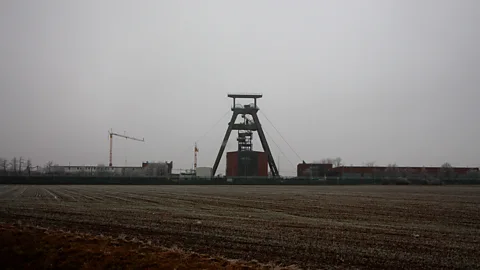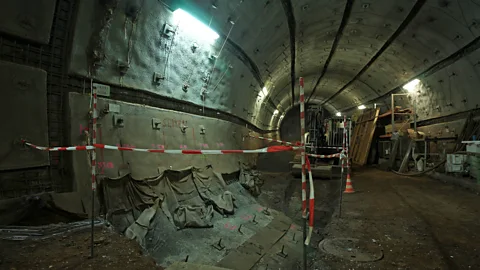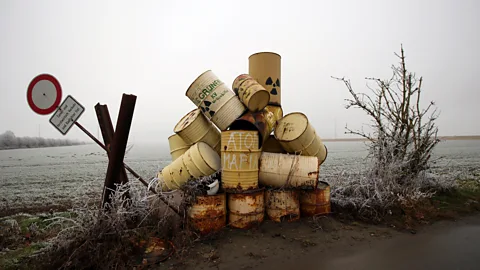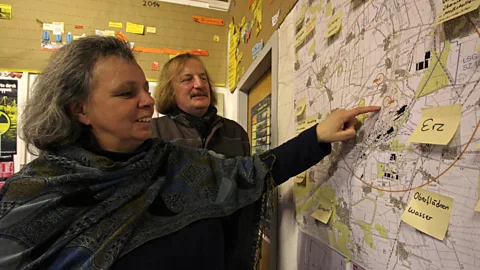The controversial plan to fill a mine with nuclear waste
 Chris Baraniuk
Chris BaraniukThe first long-term repository of its kind in the world, a disused iron mine in is getting ready to receive 300,000 containers of nuclear waste – but not everyone is happy.
It takes nearly five minutes for the lift to reach the foot of the mineshaft. The ride down is solemn and quiet, the silence broken only by the gentle clanking of the cage on its vertical tracks. Light from the torches hanging around our necks sways across the lift’s floor as we descend.
At the bottom, we a few old carts that used to ferry iron ore back and forth through these dim, rust-coloured tunnels. The Konrad mine in Salzgitter, , produced iron for more than a century, from 1867 to 1976. Over the years its labyrinth was extended to depths up to 1,300m (4,300ft) below street level. But the disused mine now has a new role – one that could last hundreds of thousands of years.
 Chris Baraniuk
Chris BaraniukIf all goes to plan, in five years Konrad’s tunnels will become home to more than 300,000 cubic metres (10,000,000 cubic ft) of radioactive waste from ’s nuclear power stations – roughly half of all the nuclear waste has ever produced. Buried deep underground, the material will be left to slowly decay. But not everyone is happy with the idea. Locals have been campaigning against the plans since they were first sketched out in the 1970s – and they haven’t given up yet.
The problem of what to do with nuclear waste has confounded us ever since we fired up the first nuclear reactors more than 60 years ago. Some of the radioactive elements produced in nuclear reactors take decades to decay. Others – like plutonium-239, neptunium-237 and iodine-219 – can linger for thousands of years. For many, burying it deep underground in secure containers is probably our best option. Finland recently approved a plan to do this on the rocky island of Olkiluoto and South Korea has already begun interning nuclear waste from some of its power plants in huge underground storage rooms at Gyeongju in the south-east of the country. But no one knows exactly how these repositories will fare over millennia.
Geologist Johannes Schneider brings our vehicle – a kind of open-topped tour van – to a halt and jumps out. In the darkness, a huge mining machine is illuminated by our torches. “We cut about four metres in 24 hours at present,” says Schneider, gesturing towards its fearsome teeth. “After two metres, the machine stops and then we have to reinforce the rock. The miners put mesh wire onto the rock and press roof bolts in to tighten it.”
Despite Konrad’s sprawling network of existing tunnels, the mine is being extended to house the waste. Some ages are being enlarged to make room for the machinery that will move the waste into place. The old mine is also getting a refit. Miners are installing new ventilation systems in an effort to keep the red dust – which covers everything – at bay. The mine will have subterranean workshops too, where the machinery used down here can be serviced. He also points out the toilets, which decompose another sort of waste on-site.
To get the mine ready for the first shipment of nuclear waste in 2022, hundreds of miners are working seven-hour shifts underground. Each worker carries a torch and a self-rescue kit that will supply oxygen for an hour or two if there is an emergency, such as a fire. As groups each other they say “Glück auf!”– an old German miners’ saying that means, roughly, “good luck”. At the entrance to the tunnels there is also a shrine to Saint Barbara, who is said to watch over miners, artillerymen and those who work with explosives.
 Chris Baraniuk
Chris BaraniukTo get government approval, the process of filling the mine with radioactive material has had to be outlined in detail. Over the course of a few decades, trains and trucks will deliver nuclear waste that has been compressed and sealed in special containers. The containers will be brought underground via one of Konrad’s existing mineshafts and then moved to their final resting place in one of the many tunnels by human-operated machines. The containers will be stacked in piles and sealed off every 50m (164ft) by a wall of concrete. The space behind these walls will be back-filled with yet more concrete as the tunnels are gradually packed with waste.
By chance, the year that Konrad is expecting its first delivery is the year ’s remaining nuclear power stations will be shut down. has toyed with abandoning nuclear power for some time and Angela Merkel’s government finally decided to do so in 2011, following the Fukushima nuclear accident in Japan. Even so, waste from the decommissioned plants – and contaminated material from the buildings – will remain radioactive for many thousands of years.
The Konrad mine has been pegged as a potential repository for nuclear waste since the mid-1970s. But a licence to store such material here was only granted in 2007 and there have been delays since. Containment was supposed to have begun already, but has been pushed back nearly 10 years. A government spokeswoman explains that this is because some of the shafts required reconstruction to make them safe.
 Chris Baraniuk
Chris BaraniukThe delay has had knock-on effects. In 2014, barrels of nuclear waste destined for Konrad that were in temporary storage at a decommissioned power plant were found to be corroded. They are being kept in concrete-walled pits not intended for long-term storage. Costs are also mounting. It is estimated that ’s Office for Radiation Protection – a government agency – is spending more than 3.4 bilion euros (£2.9bn) converting Konrad into a repository and moving waste into it, and more delays would only increase that sum.
Konrad was picked partly because it is an unusually dry mine, thanks to a 400m (1300ft) thick layer of clay that seals off the mine from groundwater. One of the greatest fears about storing radioactive waste underground is that seeping water could gradually erode containment vessels and carry radioactive material up to the surface. Even if the process took thousands of years it could still be disastrous.
“There is some moisture here,” its Schneider as he points out a row of bright white stalactites. But they are largely made of salt and he says saline solutions are less mobile than fresh water underground. Those involved in the project believe it would take at least 300,000 years for this moisture to rise to the surface. By then, the waste’s radioactivity should be harmless.
Show of opposition
The village of Bleckenstedt lies a two-minute drive away from Konrad’s main entrance. Bright yellow oil drums, painted to look like canisters of radioactive material, sit at the side of the road and in people’s gardens. It’s just one way that a handful of the village’s roughly 600 residents have chosen to show their opposition to the neighbouring mine’s transformation into a nuclear waste dump. There are also signs from anti-nuclear marches on display and an elaborate mural painted on a barn door that warns about the dangers of radiation.
One resident is unhappy because he bought an apartment a decade ago, before Konrad was granted the licence for nuclear waste storage. He claims the value of his property has since fallen to a third of what it was. He believes the German government should compensate locals for the effect on property value. Another local tells me she is worried about something going wrong in the mine. “We see what happened in Asse,” she says.
 Chris Baraniuk
Chris BaraniukAsse II, just 25km away, is the name of another former mine – and perhaps ’s biggest nuclear waste mishap. It is home to 126,000 barrels of radioactive material that were dumped there in ramshackle piles between 1967 and 1978. Radioactive brine was found to be leaking in the mine some years later and this became public knowledge in 2008. No one knows exactly what to do about the problem. In theory, the waste from Asse II could be brought to the new repository, says Konrad’s spokeswoman. But Konrad’s current licence does not allow for this.
Rosemarie Streich, who has lived in Bleckenstedt her whole life, invites me in to her house. Now in her 80s, Streich recalls ing protests about Konrad back in the 1970s. She still attends demonstrations today. “Obviously, I am aware that it has to be stored somewhere and maybe it has to be here,” she says. “But the problem is how it came about.” She doesn’t feel those behind the project have always been transparent with residents about the risks involved. She thinks that the protests have had an effect, however – by delaying the project.
That’s also the opinion of Ludwig Wasmus, a local farmer, and Ursula Schönberger, a political activist. Wasmus was born here and quickly became part of the anti-Konrad movement. “It was kind of natural,” he says. Schönberger is originally from Munich, but has been taking part in anti-nuclear demonstrations for 35 years. Today, her daughter is with her. “The next generation,” Schönberger says.
Wasmus and Schönberger are of a committee opposing the Konrad repository that was founded following the Chernobyl nuclear disaster – 2017 is its 30th anniversary. The organisation now has a small building in Bleckenstedt that serves as a meeting place and anti-nuclear information centre. The walls are plastered with leaflets and posters – including one with a picture of the higgledy-piggledy pile of barrels in Asse II.
They both feel that Konrad has been foisted upon them without consultation. “If we inspected all the different sites and we came to the conclusion that Konrad is actually the safest place, I would have trouble not agreeing with that,” says Schönberger. The problem is that it’s all been presented as a done deal, says Wasmus. “They just picked this one spot, this is it.”
 Chris Baraniuk
Chris BaraniukOne of their concerns is that has far more nuclear waste than can be stored at Konrad, which suggests that another site will have to be found to hold the rest. “We will have two regions that are contaminated,” says Schönberger. “It makes no sense.”
“The movement will continue,” says Wasmus. “We still believe we can avoid Konrad and actually stop it.”
The German authorities are sticking with their plan, however. Everyone, including the protestors, agrees that something must be done to store nuclear waste safely for the long term. But storing it underground means gaining the acceptance of whoever lives nearby. In the UK, for example, that battle is very much ongoing, and no such repositories have yet been approved.
Beneath Bleckenstedt, the miners continue their work. The tunnels of Konrad, snaking for miles below the surface, will soon be ready to receive a huge portion of ’s nuclear waste. The only visible sign that it’s there might be the high security facility above ground – and the yellow oil drums.
Keep up to date with Future Now stories by ing our 800,000+ fans on Facebook, or follow us on Twitter, Google+, LinkedIn and Instagram.
If you liked this story, sign up for the weekly bbc.com features newsletter, called “If You Only Read 6 Things This Week”. A handpicked selection of stories from BBC Future, Earth, Culture, Capital and Travel, delivered to your inbox every Friday.
